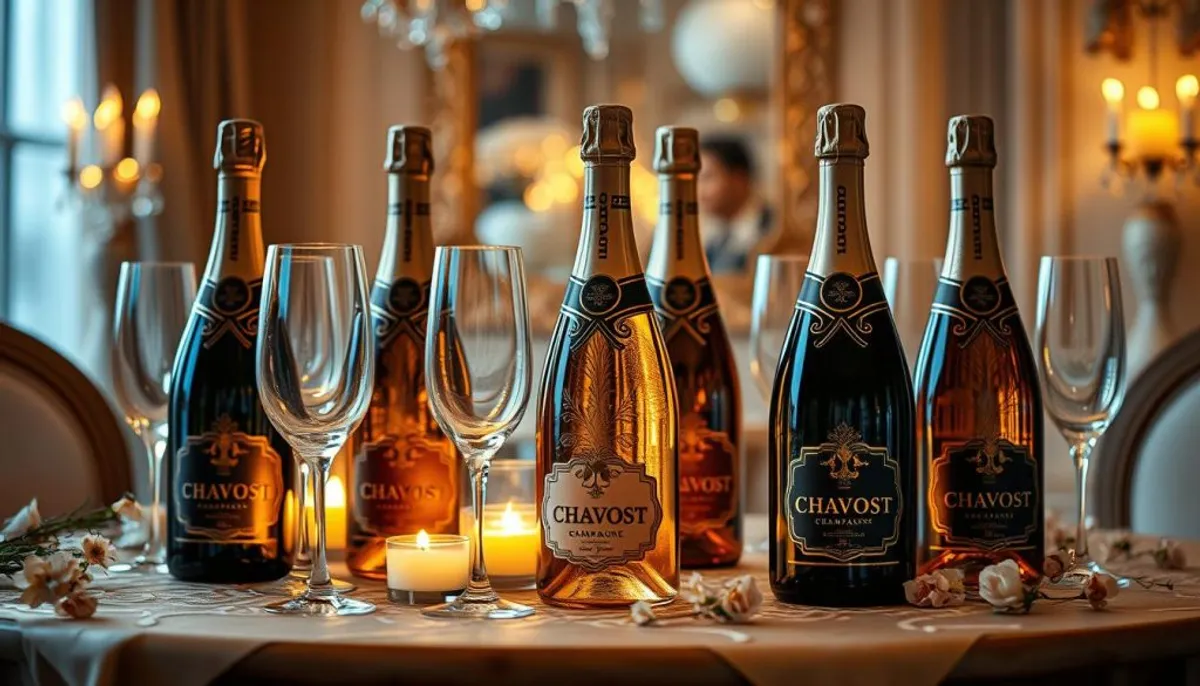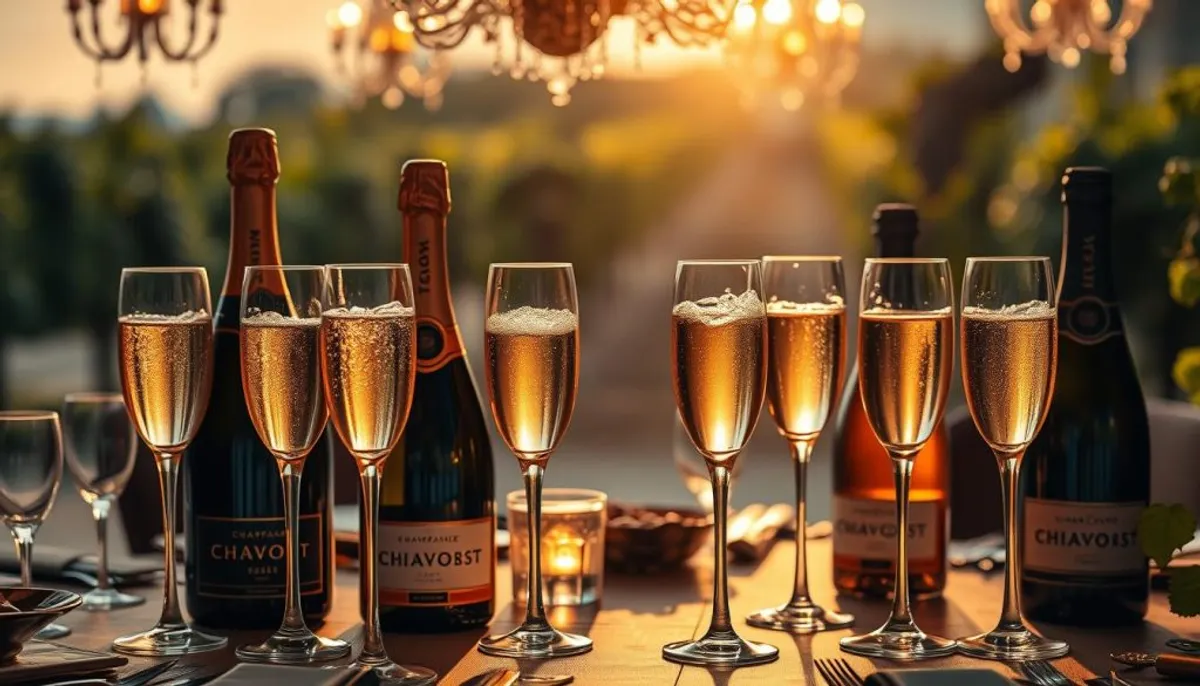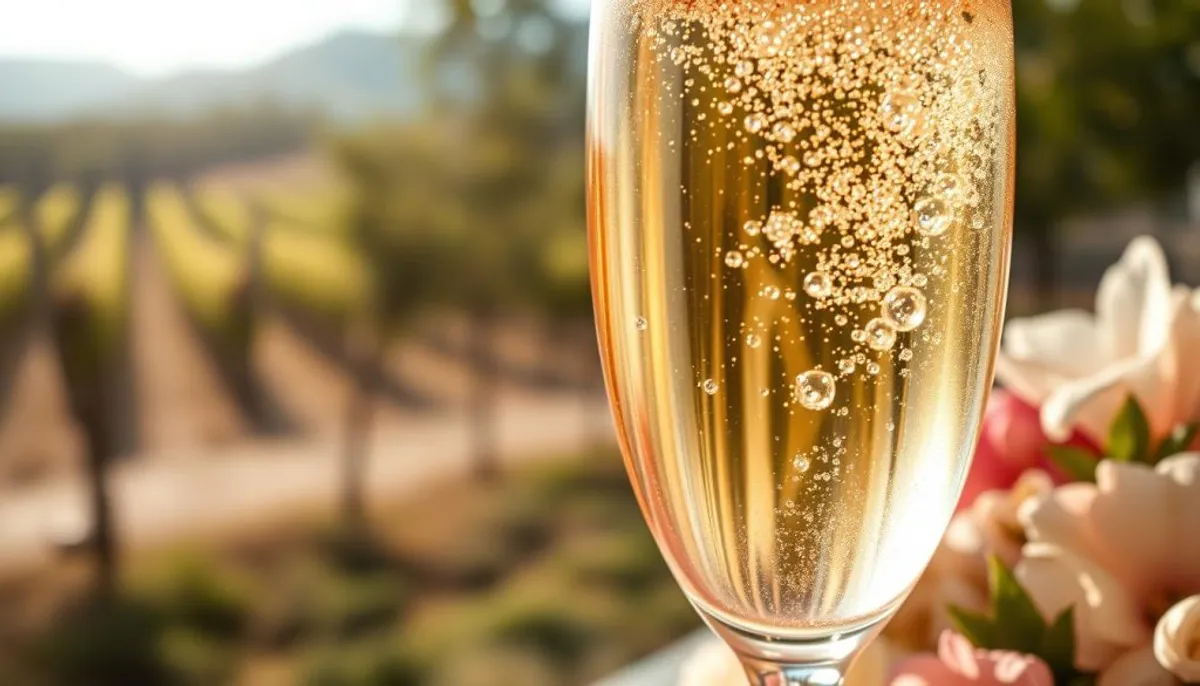Enter the realm of prestigious French wine with Champagne Chavost. This artisanal champagne house, situated in the heart of Chavot-Courcourt, has been perfecting its craft since 1946. Their dedication to natural winemaking and organic practices ensures a refined taste that stands out.
Champagne Chavost is renowned for its zero-intervention approach. They employ only the finest first press juice and allow for spontaneous fermentation. This meticulous process results in champagnes with delicate bubbles and unparalleled purity.

In 2023, Champagne Chavost achieved organic certification, marking a significant milestone. Their signature Blanc de Meunier Brut, crafted from 100% Pinot Meunier grapes, highlights the unique terroir of clay-limestone soils. Each sip reveals notes of stewed red fruit, white flowers, and crisp apples, creating a memorable experience that includes rich champagne tasting notes.
Key Takeaways
- Established in 1946 in Chavot-Courcourt, Epernay region
- Organic certified as of 2023
- Zero-intervention winemaking philosophy
- Uses 100% Pinot Meunier grapes for signature champagne
- Offers a range of sulphite-free cuvées
- Known for delicate bubbles and refined taste
- Manual harvesting techniques preserve grape quality
A Legacy of Excellence Since 1946
Champagne Chavost’s history is deeply rooted in the French winemaking tradition. This family-owned estate has been crafting exceptional champagnes for over seven decades. It embodies the essence of quality and innovation in the Champagne region.
The Origins in the Village of Chavost
The story of Champagne Chavost began in 1946 in the picturesque village of Chavost. The founders, driven by their passion for winemaking, established an estate. It would soon become synonymous with excellence in champagne production.
Values of Solidarity and Land Sharing
At the heart of Champagne Chavost’s philosophy lies a commitment to solidarity and land sharing. These values have guided the estate’s practices since its inception. They foster a sense of community and sustainable growth in the region.
Family Heritage and Traditions
The Chavost family’s dedication to their craft has been passed down through generations. This rich heritage is reflected in every bottle. It blends time-honored techniques with modern innovations to create champagnes of unparalleled quality.
| Year | Milestone |
|---|---|
| 1946 | Founding of Champagne Chavost |
| 1950s | Introduction of sustainable farming practices |
| 1970s | Expansion of vineyards |
| 2000s | Adoption of organic cultivation methods |
| Present | Continued innovation in champagne production |
Today, Champagne Chavost stands as a testament to the enduring spirit of French winemaking. The estate continues to produce limited quantities of exquisite champagnes, including handcrafted diamond pieces. It preserves its legacy while embracing the future of viticulture.
The Art of Natural Champagne Making
Champagne Chavost leads the charge in natural champagne production. Their dedication to zero-intervention winemaking distinguishes them in the sparkling wine realm. This method rejects additives, showcasing the terroir’s true essence.
The winemaking process at Champagne Chavost employs indigenous yeasts for fermentation. These naturally occurring microorganisms imbue each vintage with a unique flavor profile. The estate also embraces spontaneous malolactic fermentation, allowing nature to convert malic acid into softer lactic acid.
Stainless steel fermentation tanks are pivotal in preserving the mineral content from the clay-limestone soil. This equipment choice enhances the wine’s ability to reflect its terroir. As a result, champagnes from Champagne Chavost exhibit distinct character and complexity.
| Winemaking Aspect | Champagne Chavost Approach |
|---|---|
| Additives | No sulfites, enzymes, or tannins |
| Fermentation | Indigenous yeasts, spontaneous malolactic |
| Equipment | Stainless steel tanks |
| Philosophy | Zero-intervention |
The estate’s commitment to natural champagne production mirrors a rising trend in the wine industry. Champagne Chavost’s ethos aligns with consumers’ desires for authentic, terroir-driven sparkling wines. These wines embody the essence of their origin.
The Distinguished Champagne Chavost Collection
Champagne Chavost cuvées present a diverse spectrum of flavors and styles. Originating in 1946, this collection epitomizes the essence of natural winemaking in Champagne. It represents the zenith of this art form, including the unique experience of capsule champagne rl.
Blanc d’Assemblage Brut Nature
The Blanc d’Assemblage Brut Nature embodies the essence of terroir. This blend, devoid of added sugars, delivers an unadulterated taste of Champagne’s varietal diversity. At $52, it offers an unparalleled value for those desiring a genuine brut nature experience.
Blanc de Meunier Brut
Connoisseurs will find joy in the Blanc de Meunier Brut. This single-varietal cuvée is distinguished by its complex profile of stewed red fruit and white flowers. It also features notes of pear and yellow apple, making it a standout in the collection.

Blanc de Chardonnay Extra Brut
The Blanc de Chardonnay Extra Brut is mesmerizing with its aromatic depth. It presents a symphony of toasted hazelnut, jasmine, and green apple, creating a balanced extra brut. This wine exemplifies Chavost’s unwavering commitment to quality.
Rosé de Saignée
The Rosé de Saignée completes the collection with its distinctive character and rich flavor. It offers a unique perspective on rosé Champagne. Like its counterparts, it is crafted without sulfur or additives, ensuring a true reflection of the grapes.
Each Champagne Chavost cuvée, from the brut nature to the rosé de saignée, showcases the winery’s commitment to organic cultivation and zero-intervention winemaking. These limited production wines provide exclusivity and a genuine taste of Champagne’s terroir.
Terroir and Sustainable Practices
Champagne Chavost’s dedication to excellence is deeply rooted in its unique clay-limestone terroir. This exceptional soil imparts a distinct mineral character to their wines, setting them apart in the world of champagne.
Clay-Limestone Soil Characteristics
The clay-limestone terroir of Champagne Chavost’s vineyards plays a crucial role in the quality of their grapes. This soil type retains moisture well, ensuring the vines remain hydrated during dry periods. It also provides essential nutrients, contributing to the complexity and depth of flavors in the final product.
Organic Cultivation Methods
Champagne Chavost is embracing organic viticulture, transitioning its 5 hectares of vines to organic farming. This shift reflects their dedication to sustainable practices and environmental stewardship. Fabian, the winemaker, brings ten years of global vineyard experience to implement innovative organic techniques.
Manual Harvesting Techniques
At Champagne Chavost, all grapes are hand-picked to ensure optimal quality. This meticulous process allows for careful selection of only the finest fruit, preserving the integrity of each grape. The hand-picked grapes are then treated with utmost care, maintaining their flavor profiles throughout the winemaking process. Additionally, the use of capsule champagne rl enhances the presentation and preservation of these exquisite wines.
| Practice | Benefit |
|---|---|
| Clay-limestone terroir | Enhanced mineral content in wines |
| Organic viticulture | Environmentally friendly grape production |
| Hand-picked grapes | Preserved quality and flavor integrity |
Zero-Intervention Winemaking Philosophy
Champagne Chavost champions a zero-intervention winemaking ethos. This ethos celebrates the unadulterated essence of their terroir through natural fermentation. The winemakers adhere to minimal intervention, permitting the grapes to reveal their authentic character without artificial interference. Additionally, the champagne tasting notes provide insight into the unique flavors and aromas that emerge from this careful process.
The core of this philosophy is the rejection of added sulfites. This stance amplifies the wine’s natural flavors and aromas, leading to a more genuine representation of the vineyard. The absence of sulfites also caters to those desiring a more natural wine experience.
The winemaking process at Champagne Chavost is centered around spontaneous fermentation. This method leverages the native yeasts on the grape skins, initiating fermentation naturally. The outcome is a champagne with distinctive flavor profiles that mirror its origins.
Another pivotal element of their minimal intervention strategy is the eschewal of fining at the conclusion of vinification. This decision fosters the development of complex yeasty notes and depth of flavor. The champagne retains its natural essence, offering a rich and nuanced tasting experience.
| Winemaking Aspect | Champagne Chavost Approach |
|---|---|
| Fermentation | Natural, spontaneous |
| Sulfites | No added sulfites |
| Fining | No fining process |
| Intervention | Minimal to zero |
This dedication to natural winemaking resonates with the increasing popularity of organic and biodynamic practices in the wine sector. Champagne Chavost’s methodology not only safeguards the integrity of their terroir but also crafts wines that are uniquely and profoundly expressive.
Tasting Notes and Flavor Profiles
Champagne Chavost presents a sensory delight. Each sip uncovers a tapestry of flavors, reflecting the brand’s dedication to excellence and artistry.
Aromatic Complexity
The aroma of Champagne Chavost wines is enchanting. It combines stewed red fruits with delicate white floral scents, inviting the senses. Toasted hazelnuts and jasmine subtly enhance the bouquet, adding layers to the olfactory experience.

Palate Characteristics
The champagnes’ palate is a showcase of complexity. A velvety texture caresses the palate, while mineral undertones refresh. This interplay of textures and flavors achieves a harmonious balance, leaving a lasting impression.
Aging Potential
Champagne Chavost wines exhibit remarkable aging potential. The Coteaux Champenois 2019, for instance, shows a potential for gradual evolution. With proper storage, it can refine its flavors for up to a decade, especially when served in a luxury champagne bucket.
| Wine | Aromatic Profile | Palate | Aging Potential |
|---|---|---|---|
| Blanc d’Assemblage | White flowers, citrus | Crisp, mineral-driven | 3-5 years |
| Blanc de Meunier | Red fruits, nutty notes | Full-bodied, creamy | 5-7 years |
| Coteaux Champenois | Stewed fruits, toasted nuts | Complex, layered | Up to 10 years |
Limited Production and Exclusivity
Champagne Chavost distinguishes itself in the realm of sparkling wines through its commitment to small-batch champagne production. The estate prioritizes quality over quantity, leading to exclusive production runs that garner significant anticipation among wine aficionados.
Each vintage from Champagne Chavost exemplifies the concept of limited availability. For instance, the Coteaux Champenois 2019 saw only 1,182 bottles released, cementing its status as a coveted collector’s item.
This approach to exclusive production enables Champagne Chavost to uphold rigorous quality standards. Every bottle undergoes meticulous scrutiny, guaranteeing that each sip embodies the unparalleled taste the brand is renowned for.
| Vintage | Bottles Produced | Availability |
|---|---|---|
| Coteaux Champenois 2019 | 1,182 | Very Limited |
| Blanc d’Assemblage Brut Nature | 3,500 | Limited |
| Rosé de Saignée | 2,800 | Limited |
The scarcity of Champagne Chavost’s offerings significantly enhances their appeal. Wine collectors and connoisseurs value the rarity, recognizing each bottle as a unique masterpiece from this prestigious Champagne house.
Perfect Pairing Suggestions
Champagne Chavost presents a selection of wines, each designed to elevate your dining experiences. The art of pairing champagne with food not only enhances the taste of both but also creates unforgettable moments. These pairings are ideal for special occasions, making every event memorable. For a truly elegant touch, consider serving a champagne lbd alongside your meal.
Culinary Companions
The Blanc de Chardonnay Extra Brut from Champagne Chavost pairs exceptionally well with seafood. Its crisp acidity perfectly complements oysters and light fish dishes. For those who prefer heartier options, the Blanc de Meunier Brut is a great choice for white meats such as roasted chicken or turkey.
The Rosé de Saignée is a perfect match for charcuterie boards. Its fruity notes beautifully enhance the savory flavors of cured meats and cheeses. For vegetarian dishes, the Blanc d’Assemblage Brut Nature pairs well with grilled vegetables or mushroom-based dishes.
Serving Temperature
Proper serving temperatures are crucial to fully appreciate Champagne Chavost. Most cuvées should be served between 45-50°F (7-10°C). Vintage selections, on the other hand, benefit from a slightly warmer temperature of 50-54°F (10-12°C). This allows the complex flavors to fully develop.
Occasion Recommendations
Champagne Chavost wines are suitable for a variety of special occasions. The Blanc d’Assemblage Brut Nature is an excellent choice for elegant dinner parties as an aperitif. For celebratory toasts, the Blanc de Chardonnay Extra Brut is ideal. The Rosé de Saignée adds a romantic touch to anniversary dinners or Valentine’s Day celebrations.
| Champagne | Average Price | Rating |
|---|---|---|
| Champagne Chavost Assemblage NV | $60 | 93 |
| Champagne Billecart-Salmon Brut Réserve NV | $70 | 93 |
| Champagne Delamotte Brut NV | $71 | 92 |
Global Export and Availability
Champagne Chavost is committed to exporting its exquisite wines globally, catering to wine aficionados worldwide. The estate, along with other family-run champagne estates, ensures that premium offerings are accessible internationally, enhancing the global availability of their unique cuvées.
Ordering champagne from Chavost is a streamlined, personalized experience. Customers can request tailored quotes for international shipping, ensuring a seamless acquisition process. The estate meticulously packages and handles each bottle, guaranteeing its arrival in pristine condition. This dedication to quality is what Chavost is renowned for.
The global demand for Chavost’s champagnes is evident in the wine industry statistics. At prestigious wine showcases, Chavost’s offerings stand out among over 200 selections from around the world. Their “Eurêka! Méthode Nature” and “Blanc de Meunier Brut Nature” are priced at $240 and $135 respectively, showcasing the brand’s diverse range and commitment to quality.
Champagne Chavost’s dedication to environmental betterment is showcased through their line of cuvées with no added sulfites, appealing to eco-conscious consumers worldwide. This unique approach, combined with their traditional range, positions Chavost as a sought-after brand in the global champagne market.
Conclusion
Champagne Chavost epitomizes French wine excellence, showcasing a blend of ancient traditions and modern natural winemaking. This results in exquisite bubbles that embody the Champagne region’s terroir. It’s a true reflection of the region’s essence.
Since 1946, this family-owned estate has been rooted in the village of Chavost. They have perfected the art of creating limited-production champagnes. Their dedication to organic cultivation and zero-intervention winemaking distinguishes them in a region that produces over 300 million bottles annually, including methods focused on preserving nutrients in vegetables.
Their champagnes, from the crisp Blanc d’Assemblage to the elegant Rosé de Saignée, showcase the unique clay-limestone soil of the area. These champagnes present complex aromas and flavors that mature beautifully with age. They are ideal for special occasions or thoughtful food pairings.
Exploring Champagne Chavost is more than just tasting wine; it’s experiencing French heritage, bottled with meticulous care and expertise. It highlights the timeless appeal of artisanal champagne in today’s wine world.
RelatedRelated articles



